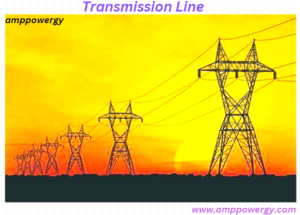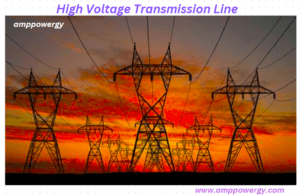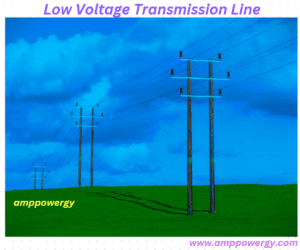What are High and Low Voltage Transmission Lines?
What are Transmission lines?
In the context of electrical engineering, a transmission line refers to a system of conductors that facilitate the transmission of electrical energy from one point to another. These lines play an important role in power generation, transmission and distribution. Here is an overview of transmission lines.

Purpose of the transmission lines
Power transmission: Transmission lines are designed to transport large amounts of electricity over long distances, connecting power generation plants to substations and, later, to distribution networks.
Efficiency: High voltage transmission lines are used to minimize energy losses during long distance transportation of electricity. According to Ohm’s law (P = I²R), reducing the current by increasing the voltage helps to reduce the power losses in the form of heat.
components of transmission line
Conductors: Usually made of aluminum or copper, these conductors carry electrical current. The choice of material depends on factors such as conductivity, weight, and cost.
Insulators: Support structures use insulators to prevent the flow of current to ground. Insulators are usually made of ceramic or composite materials.
Towers / Poles: Support structures that elevate and route transmission lines. The height and design depend on factors such as area and length of transmission line.
Types of Transmission Lines
Overhead Lines: The most common type, where conductors are suspended above ground on towers or poles.
Underground cables: Transmission lines can be buried underground in urban areas or environmentally sensitive areas. This method reduces visual impact and reduces exposure to electromagnetic fields.
Voltage level of the transmission line
High Voltage (HV): Usually over 1000 volts, used for long distance power transmission.
Extra High Voltage (EHV) and Ultra High Voltage (UHV): Transmission lines with voltages in the hundreds of kilovolts or megavolts, reduce energy losses during transmission.

Challenges and Concerns in transmission lines
Energy losses: Resistance in conductors leads to energy losses in the form of heat. Higher voltages help reduce these losses.
Corona Discharge: At high voltages the air around the conductors can become ionized causing corona discharge and energy loss.
Environmental Impacts: Transmission lines can have visual, environmental and health impacts, requiring careful consideration of routes and technologies.
Regulations and Standards of transmission lines
Grid Codes: Transmission lines must follow grid codes and standards set by regulatory bodies to ensure the reliability and stability of the power grid.
What are high voltage Transmission lines?
High-voltage lines, also known as high-voltage transmission lines, form an important component of electric power infrastructure, which play an important role in the efficient and long-distance transmission of electric power. These lines are designed to transport large amounts of electricity from power generation sources to distribution networks, ensuring that electricity reaches homes, businesses and industries.
Purpose of High Voltage Transmission Lines:
Power Transmission
High-voltage lines are specially engineered to transmit electricity over extended distances, connecting power plants, often located in remote areas, to substations near population centers.The main objective is to facilitate the efficient transfer of large amounts of electricity from where it is generated to where it is needed.
Components of High Voltage Lines:
Conductor
High voltage lines use specially designed conductors, often made of aluminum or aluminum alloys, chosen for their high conductivity and relatively light weight compared to other materials.The choice of conductors is important to balance electrical efficiency, mechanical strength, and cost considerations.
Insulator
Support structures, such as towers or poles, use insulators to prevent electrical current from flowing into the ground. Insulators are usually made of ceramic or composite materials that have high dielectric strength.
Tower / Pole
Transmission towers or poles provide the necessary physical support for conductors and insulators. These structures are strategically designed based on factors such as terrain, environmental considerations and transmission line length.
Voltage levels and types
High Voltage (HV):High voltage lines usually operate at voltages above 1000 volts (1 kV).
The extra high voltage (EHV) and ultra-high voltage (UHV): these categories include lines with voltages from hundreds of kilovolts to several megavolts.
Types of High Voltage Lines:
Overhead Lines: The most common type, where conductors are suspended on towers or poles.
Underground cables: In some cases, high voltage lines can be routed underground, especially in urban areas or environmentally sensitive areas.
Challenges and Concerns in High Voltage Transmission Lines
Energy Losses: Resistance in conductors leads to energy losses in the form of heat. It helps reduce high voltage currents and consequent energy losses.
Corona discharge:At high voltages, corona can discharge, causing energy losses and audible noise. Special designs and materials are used to reduce the effects of corona.
Environmental Effects:Visual effects and potential health concerns related to electromagnetic fields are important considerations in planning high-voltage transmission projects.
conclusion of High Voltage Transmission
Finally, high voltage lines are important elements in power transmission and distribution networks, serving as the backbone for power supply over vast distances. Their design and operation are guided by the principles of efficiency, reliability, and environmental considerations to ensure a continuous and safe supply of electrical energy to communities and industries.
What are Low Voltage Transmission Lines?
Low voltage transmission lines are an integral part of the electric power distribution system, responsible for carrying electric power from substations to end users such as residential, commercial and industrial facilities. These lines operate at lower voltage levels than high-voltage transmission lines and are designed to meet the specific needs of local distribution networks.
Purpose of low voltage transmission lines
Power Distribution:Low-voltage transmission lines are designed for the final stage of power distribution, delivering power from substations to homes, businesses, and otherconsumers. Their purpose is to ensure that electricity reaches consumers at a safe and usable voltage level.
End User Applications:Low voltage lines are responsible for supplying electricity to various appliances and devices in homes and businesses, including lighting, heating, air conditioning, and electronic equipment.
Components of Low Voltage Transmission Lines:
Conductor:Conductors used in low voltage lines are usually made of copper or aluminum. The choice depends on factors such as conductivity, cost and weight.
Insulator:Insulators are used to support conductors and prevent current from flowing to ground. Insulator materials often include ceramics or composite materials.
Poles and Towers:Support structures, which may be poles or small towers, provide physical support for transmission lines. These structures are designed based on local environment, region and distribution network requirements.
Voltage level
Low Voltage (LV):Low voltage lines generally operate at voltage levels below 1000 volts.Common low voltage levels include 120V and 240V in residential areas, but they may vary based on regional standards and applications.
Types of low voltage Transmission lines
Overhead Lines: Overhead lines are generally used for low voltage distribution. They consist of conductors running on poles or small towers.
Underground Cables:In urban areas or locations with specific aesthetic and environmental considerations, low voltage lines can be installed underground to reduce visual impact.
Challenges and Concerns in Low Voltage Transmission Line
Voltage Drop: Low-voltage lines can experience voltage drops over long distances, causing voltage drops at the end of the line. Proper design and voltage regulation are used to minimize this effect.
Load Balance:Distribution networks must be carefully balanced to ensure that voltage levels remain within acceptable limits, particularly during peak demand times.
conclusion
Low-voltage transmission lines are the last link in the power distribution chain, connecting substations to homes and businesses. Their design and operation are tailored to meet the specific needs of end users, providing reliable and secure power supply for various applications. Proper planning and maintenance are essential to ensure efficient functioning of low voltage transmission lines in supplying electricity to consumers.
Calculation for high and low voltage transmission line
The calculation of high and low voltage transmission lines involves various electrical parameters, including voltage, current, resistance, power, and energy losses. Several formulas are used in the analysis and design of high and low voltage transmission lines. Here are some important calculations and formulas.
Calculation of voltage drop
Voltage drop is an important factor in transmission lines to maintain the required voltage level at the load end. voltage drop (Vd) can be calculated using Ohm’s law:
Where:
Vd is the voltage drop.
I represent the current flowing in the transmission line.
R represent the resistance of the transmission line.
Transmission Line Impedance:
The impedance (Z) of a transmission line is the sum of resistance (R) and reactance (X). Impedance is important for calculating voltage drops and power losses.
Where:
Z is the constraint.
R is resistance.
X is the reaction.
Power loss
Power losses in transmission lines can be calculated using the formula:
Where:
P loss is power loss.
I is current.
R is resistance.
Effects of Capacitance
Capacitance (C) of a transmission line can cause power flow and voltage regulation problems. the below formula is used to find capacitance of transmission line.
Where:
C is the capacitance.
Q is the reactive power.
V is the voltage.
Effects of Induction
The inductance (L) of a transmission line affects the rate of change of current and voltage. It is calculated as follows:
Where
L represent induction.
I represent current.
Effects of Corona: Corona discharge can occur at high voltage causing power loss. Calculating the effects of corona involves complex electromagnetic field analysis.
Temperature rise:The temperature rise in transmission lines due to current flow can be estimated by calculating the thermal resistance.
It is important to note that these calculations are part of a comprehensive analysis, and the design of high voltage transmission lines also considers factors such as insulation, environmental conditions and safety standards. Additionally, specialized software tools are often used for detailed modeling and simulation of transmission line behavior.
high and low voltage transmission according to Area
The general density or distribution of high and low voltage transmission lines in a given area.
High Voltage Transmission Lines
High voltage transmission lines are generally designed for long distance transmission of electricity from power plants to substations and regions. The density of high-voltage lines depends on factors such as power demand, geographic location of the region, and the need to interconnect different parts of the power grid.
In urban areas, where electricity demand is high, you may find a high concentration of high voltage lines. Conversely, rural areas may have lower density of high-voltage transmission lines.
Low Voltage Transmission Lines (Distribution Lines)
Low-voltage transmission lines, also known as distribution lines, are designed to deliver electricity from substations to homes, businesses, and other consumers. The density of distribution lines is generally much higher than that of high voltage transmission lines.
In urban and suburban areas, where population and power demand are concentrated, you will find a dense network of distribution lines. This is necessary to ensure that electricity is delivered reliably to individual consumers.
In rural areas, where population density is low, distribution lines may be less dense, and electricity may be distributed over long distances.
It is important to note that the concentration or density of transmission lines also depends on the specific design of the power grid, the voltage level used, and the overall infrastructure planning. Additionally, environmental and regulatory considerations play a role in determining the routing and concentration of transmission lines.
See Also:
Frequently asked questions
Q: What is considered “high voltage” in transmission lines?
Ans: High voltage transmission lines typically operate at voltages above 69 kilovolts (kV). Common high voltage levels include 230 kV, 345 kV, 500 kV, and even higher.
Q: Why are high voltage transmission lines used?
Ans: High voltage is used for long-distance power transmission because it reduces power losses and allows efficient energy transfer over large distances. Higher voltages also enable the transmission of larger amounts of electricity.
Q: How are high voltage transmission lines supported?
Ans: High voltage transmission lines are supported by tall towers made of materials such as steel or concrete. These towers provide the necessary clearance and support for the conductors.
Q: What factors influence the design of high voltage transmission lines?
Ans: Factors include the distance over which electricity needs to be transferred, electricity demand, environmental conditions, regulatory requirements, and the need for reliability in the power grid.
Q: Do high voltage lines pose health risks due to electromagnetic fields (EMF)?
Ans: There are concerns about electromagnetic fields (EMF) associated with high-voltage lines, but scientific studies have not consistently shown conclusive evidence of negative health effects. Regulatory bodies often set exposure limits.
Q: What is the normal voltage range for low voltage transmission lines?
Ans: Low voltage transmission lines, also known as distribution lines, generally operate at voltages below 69 kV. Common voltage levels include 12 kV, 24 kV, and 34.5 kV.
Q: Why are low voltage transmission lines important?
Ans: Low voltage lines are used to distribute electricity from substations to end users such as homes, businesses and industrial facilities. They form the final stage of the power distribution network.
Q: How are low voltage transmission lines designed for reliability?
Ans: Distribution lines are designed with redundancy, sectionalizing devices, and other measures to increase reliability. It aims to minimize downtime and restore power quickly in the event of faults.
Q: What types of structures support low voltage transmission lines?
Ans: Distribution lines are supported by poles made of materials such as wood, steel, or concrete. These poles provide support for conductors and may include insulators to prevent electrical contact with ground.
Q: What are the challenges associated with maintaining low voltage lines?
Ans: Challenges may include vegetation management, weather-related issues (such as storms) and the need for routine inspections to identify and address potential problems before they cause disruptions.
Q: How does the density of low voltage lines differ in urban and rural areas?
Ans: In urban areas with high population density and high electricity demand, you may find a dense network of low voltage lines. In rural areas, density may be lower, and electricity may be distributed over longer distances.


